Bantam Special
Eastman Kodak Co.
| Name: | Bantam Special |
| Manufacturer: | Eastman Kodak Co. |
| Country of Origin: | USA |
| Construction: | Black enamelled cast metal body with contrasting bright metal lines; designed by Walter Dorwin Teague. The camera is equipped with a coupled rangefinder with helical focussing. |
| Plate / Film Size: | 828 rollfilm (for pictures 28 x 40 mm) |
| Movements: | None |
| Dimensions (w x h x l): | 4¾ x 3¼ x 1¾ inches |
| Production Period: | 1936 - 1940 (Compur); 1941 - 1948 (Supermatic) |
The Kodak Bantam Special was introduced during 1936, and was produced until 1948. The camera has a very striking design, consisting of a black enamelled cast aluminium body with bright metal horizontal lines. It is a fine example of a camera styled by Walter Dorwin Teague.
Walter Dorwin Teague was a graphic designer, who became interested in design for mass produced goods. Eastman Kodak started their working relationship with him in the 1920s, and it was to continue for several decades. Collectors now regard the cameras that were produced as a result of that relationship as some of the most desirable; consider cameras such as the Beau Brownies, the Vanity Kodaks, the Gift Kodak as well as the Bantam Special.
Walter Dorwin Teague designed other manufactured goods such as glassware, pottery, radios. He also produced a new standard design for Texaco gas stations. He became a highly influential and respected figure in the design world and played a key role in the creation of industrial design as a recognised discipline. The Society of Industrial Designers was founded in 1944, with Teague as its first President. He died in 1960.
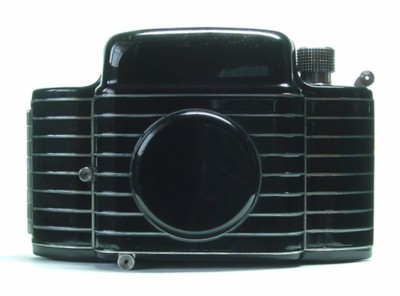
The Kodak Bantam Special is a relatively small camera, described by
Eastman Kodak in contemporary advertisements as an all-purpose miniature
instrument
.
Its closed dimensions are approximately 4¾ x 3¼ x 1¾ inches, which is compact for the time, though its profiled shape makes it quite easy to handle.
The clam-shell form was not new of course as it had been used in the early Retina cameras.
There were two significant variations of the Kodak Bantam Special as the shutter was changed from the initial Compur Rapid to a Supermatic shutter. While the version with the Supermatic shutter was produced over a much longer period but in lesser numbers, fewer working examples are to be found today as the Supermatic shutter did not prove to be as reliable as the earlier Compur. The change in shutter came about in 1941 as a consequence of course of the Second World War. The camera also had a remarkably fast lens for its time, an Ektar f/2.
The camera also boasted a coupled rangefinder with helical focusing,
described in the contemporary advertising as a military-type, split-field
.
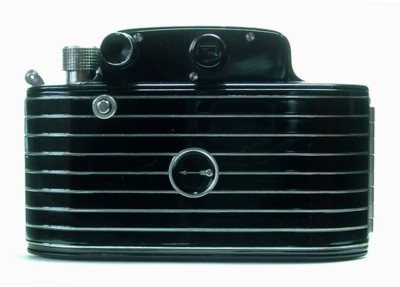
There are two viewfinder windows on the rear of the camera. The central finder is used for picture composition. The off-centre finder is the range finder. On the front face of the head block you will notice that there are three small windows. Again the central one is the main viewfinder. The two at opposite sides are key to the operation of the range finder, as is the auxiliary lens fitted to the bracket on the lens standard. This auxiliary lens is in line with the left most window. The camera is focused using the lever on the left hand side of the lens. The camera can be taken through its entire focussing range by rotating this lever through just 135 degrees.
Looking through the range finder window, the centre of the view is seen with a horizontal split line. The images either side of the split come through the different view finders, but are offset if the camera is not in focus. By moving the focus lever, the upper image in the split view moves to the left or right. When the two coincide, the camera is in focus. It sounds a little complex, but is actually relatively simple to use with a little practice.
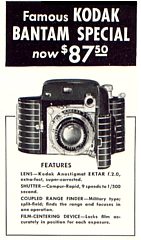 The
Kodak Bantam Special was quite an expensive camera to buy - an advert for
the Christmas season of 1936, the year the camera was introduced, gives the
list price as $110, and described it
The
Kodak Bantam Special was quite an expensive camera to buy - an advert for
the Christmas season of 1936, the year the camera was introduced, gives the
list price as $110, and described it as low indeed for an instrument of
such quality
. A later advert of 1938 leads with Remarkable in Performance
and yet moderate in Price
, but still quoting a list price of $115.
However, later in that year there was a deliberate decision to reduce the
price to $87.50, supposedly on the strength of its popularity with
amateurs. All this at a time when many other cameras were selling for
between $10 and $20! (Click on the thumbnail image to show the full
advert, including additional descriptive text, in a new window).
The camera uses 828 rollfilm, introduced in 1935 for the Bantam range of cameras and offering a picture size of 28 x 40mm, not dissimilar to 35mm film, but with the advantage of providing a larger image area. The name of the film comes from the fact that it was designed to take 8 exposures of 28mm width.
The 828 film carries a single set of perforations which are used to register the film in the camera. To wind on the user has to depress a button on the back of the camera and then turn the winder knob on the top of the camera by about half a turn, release the button and then continue turning the winder knob until it locks. This mechanism ensures that the film is kept accurately positioned for each shot (another feature that was highlighted in the advertising literature).
In my opinion this camera is a link between eras. Why? I collect cameras that tell the story of the development of photography in the period up to the late 1930s. I have always regarded the Bantam Special camera as the final entry in my timeline. Its striking design encapsulates so much of the art deco influence, and is quite unique. To my mind it captures many of the best features of the folding cameras that went before it. And yet it is also technically innovative and very well built with a reputation for reliability (at least with the Compur shutter). It seems to hint at so much of what was to come in the development of post-war cameras, such as the later types of Retina (notably those with rangefinders) and the other 35mm cameras that were to dominate the market in subsequent years.
But of course, you might not agree ...
| Lens: | Kodak Anastigmatic Ektar f2 |
| Shutter: | Compur Rapid |
| Date of this Example: | c1937 |
| Serial Number: | Serial #18685 on the foot that slides out of the baseboard |
| Availability: |
|
| Inventory Number: | 43 |
Description
Date of camera from references is 1936 to 1940 with this shutter, but the instruction booklet (which I believe to be original to this camera) has a coding on the penultimate page that suggests it could be 1937 (4-37-KP-8).
The camera was also supplied with a number of accessories (eBay seller had failed to sell them separately and bundled them with the camera, together with an unused film):
Kodachrome Haze Filter (Series VI) in yellow / black plastic tin &
original box
Kodak 5-A Portrait attachment in yellow box, with two sets of instruction
sheets enclosed.
Kodak lens hood (Series VI).
Omag red filter disc, in case & original box, with instruction sheet.
Harrison light filter (Yellow) in case.
Kodachrome K828A film in box with original processing envelope. Film is in
original aluminium container and is still wrapped in foil.
The camera itself contains a partially exposed film.
Leather case, velvet lined, which has protected the camera over the years.
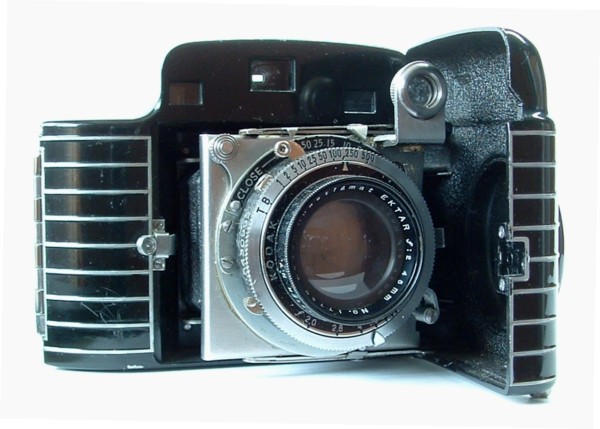
~ # ~ # ~
| Lens: | Kodak Ektar f2 |
| Shutter: | Supermatic |
| Date of this Example: | c1942 |
| Serial Number: | Serial #24281 on the foot that slides out of the baseboard |
| Availability: |
|
| Inventory Number: | 279 |
Description
This is the later version of the camera that adopted the Supermatic shutter after the Compur shutter had to be replaced following the onset of the Second World War. The Supermatic shutter adopted for the later version is less reliable than the earlier Compur; I have come across several examples where the shutter has failed.
Date of camera from references is 1941 to 1948 with this shutter. Difficult to estimate the date from the serial on this unit. Coe [4] is not able to confirm the total number made so the serial range data is not available.
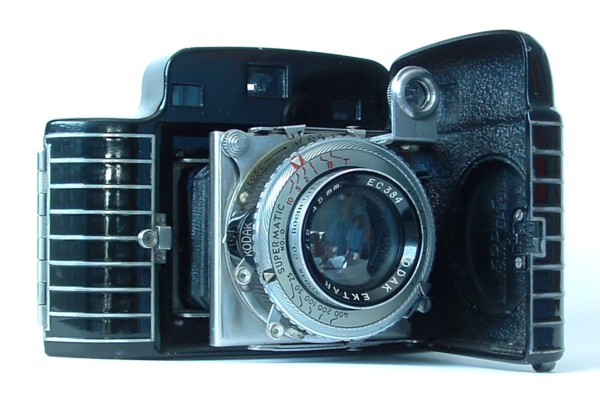
Notes
The Kodak Bantam Special is, in my humble opinion, one of the most beautiful cameras you might encounter in the collecting world. They were made in sufficient numbers to mean that it is also quite possible to end up owning one.
The Supermatic is harder to find than the earlier Compur version. While the former was made over a longer period, it appears possible that actual numbers made was less. However, given that the Supermatic shutter was less reliable it is not inconceivable that a higher proportion of this variant have been thrown away by frustrated users over the years reducing the number remaining in circulation today.
Look out for scratches and chips in the black enamel. Good The flaws often don't show up until you are able to inspect the camera at close quarters under strong lighting! A camera that has been cased is often a better bet, but even then may still be damaged through nothing more than user wear and tear.
The cameras occasionally turn up with their original black and silver boxes. Examples in good condition often fetch considerable more than the camera alone.
![[ ]](../../images/unchecked.png)
![[x]](../../images/checked.png)